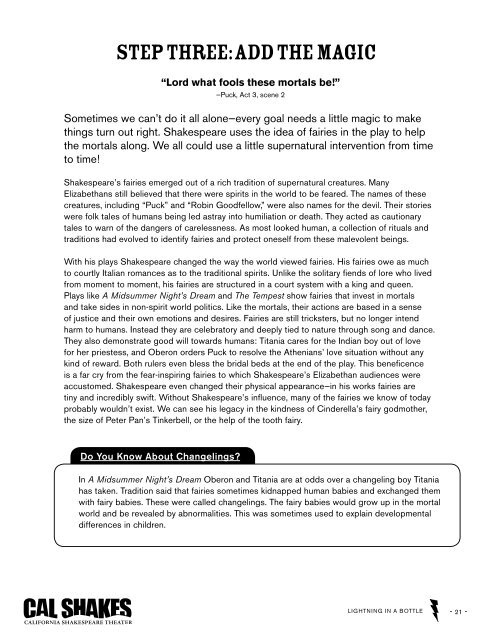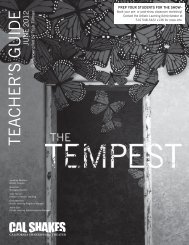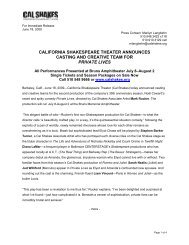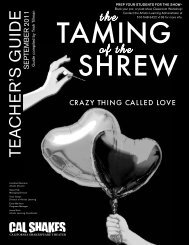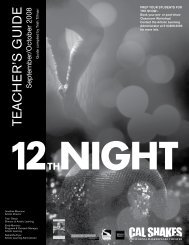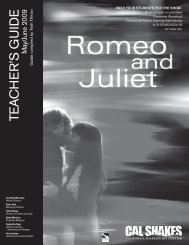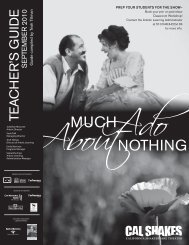A Midsummer Night's Dream - California Shakespeare Theater
A Midsummer Night's Dream - California Shakespeare Theater
A Midsummer Night's Dream - California Shakespeare Theater
Create successful ePaper yourself
Turn your PDF publications into a flip-book with our unique Google optimized e-Paper software.
STEP THREE: Add the magic<br />
“Lord what fools these mortals be!”<br />
—Puck, Act 3, scene 2<br />
Sometimes we can’t do it all alone—every goal needs a little magic to make<br />
things turn out right. <strong>Shakespeare</strong> uses the idea of fairies in the play to help<br />
the mortals along. We all could use a little supernatural intervention from time<br />
to time!<br />
<strong>Shakespeare</strong>’s fairies emerged out of a rich tradition of supernatural creatures. Many<br />
Elizabethans still believed that there were spirits in the world to be feared. The names of these<br />
creatures, including “Puck” and “Robin Goodfellow,” were also names for the devil. Their stories<br />
were folk tales of humans being led astray into humiliation or death. They acted as cautionary<br />
tales to warn of the dangers of carelessness. As most looked human, a collection of rituals and<br />
traditions had evolved to identify fairies and protect oneself from these malevolent beings.<br />
With his plays <strong>Shakespeare</strong> changed the way the world viewed fairies. His fairies owe as much<br />
to courtly Italian romances as to the traditional spirits. Unlike the solitary fiends of lore who lived<br />
from moment to moment, his fairies are structured in a court system with a king and queen.<br />
Plays like A <strong>Midsummer</strong> Night’s <strong>Dream</strong> and the tempest show fairies that invest in mortals<br />
and take sides in non-spirit world politics. Like the mortals, their actions are based in a sense<br />
of justice and their own emotions and desires. Fairies are still tricksters, but no longer intend<br />
harm to humans. Instead they are celebratory and deeply tied to nature through song and dance.<br />
They also demonstrate good will towards humans: Titania cares for the Indian boy out of love<br />
for her priestess, and Oberon orders Puck to resolve the Athenians’ love situation without any<br />
kind of reward. Both rulers even bless the bridal beds at the end of the play. This beneficence<br />
is a far cry from the fear-inspiring fairies to which <strong>Shakespeare</strong>’s Elizabethan audiences were<br />
accustomed. <strong>Shakespeare</strong> even changed their physical appearance—in his works fairies are<br />
tiny and incredibly swift. Without <strong>Shakespeare</strong>’s influence, many of the fairies we know of today<br />
probably wouldn’t exist. We can see his legacy in the kindness of Cinderella’s fairy godmother,<br />
the size of Peter Pan’s Tinkerbell, or the help of the tooth fairy.<br />
Do You Know About Changelings?<br />
In A <strong>Midsummer</strong> Night’s <strong>Dream</strong> Oberon and Titania are at odds over a changeling boy Titania<br />
has taken. Tradition said that fairies sometimes kidnapped human babies and exchanged them<br />
with fairy babies. These were called changelings. The fairy babies would grow up in the mortal<br />
world and be revealed by abnormalities. This was sometimes used to explain developmental<br />
differences in children.<br />
LIGHTNING IN A BOTTLE<br />
- 21 -


